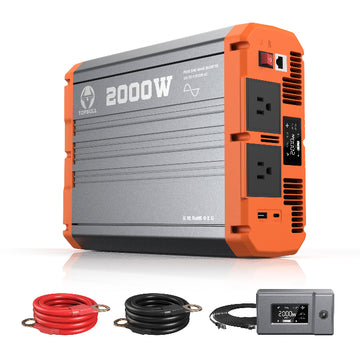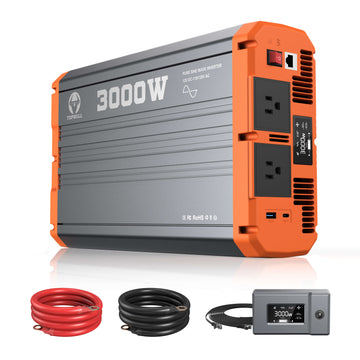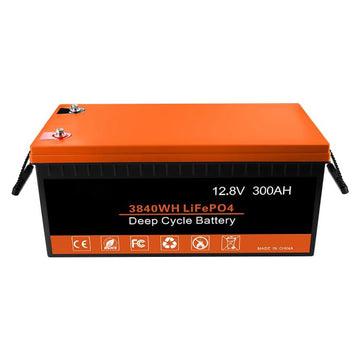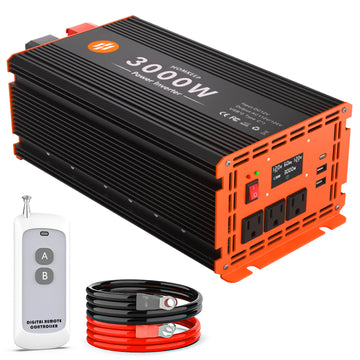Lithium-ion batteries are now an integral part of our lives. Powering everything from smartphones to drones, 3.7V batteries are ubiquitous, but many people don't know how they work. This article focuses on 3.7V lithium batteries.
Inside this Article:
- Understanding 3.7V lithium batteries
- Can I charge 3.7V batteries?
- How to charge a 3.7 V Li-ion battery?
- 3.7V battery types and uses
- Advantages and limitations of 3.7V batteries
- How do I choose the right 3.7V lithium-ion battery?
- How long does a 3.7 V lithium-ion battery last?
- Factors that affect battery life
- Conclusion
Understanding 3.7V lithium batteries
3.7V is the voltage used by ternary Li-ion batteries, with capacities ranging from a few hundred to a few thousand mAh, which are commonly used to power a wide range of instruments, smartphones, drones, cameras, and other devices that require a lightweight, high-capacity power source. The larger the size of a single lithium battery, the greater the capacity, or the more lithium batteries are connected in parallel, the greater the capacity.
However, not all lithium batteries have the same voltage, the voltage of lithium-ion batteries depends mainly on the anode and cathode materials of your batteries. Lithium iron phosphate is 3.2V. General purpose lithium cobalt oxide, ternary cathode with graphite anode can reach a full charge voltage of around 4.2V, whereas lithium iron phosphate can only reach 3.6V. The nominal voltage of 3.7V represents the average operating voltage during the discharge cycle.
- High energy density: stores more energy per unit weight than other types of battery.
- Lightweight: ideal for devices where weight is an issue.
- Long life: can be recharged many times before performance degrades significantly.

Can I charge 3.7V batteries?
Sure, most 3.7V batteries are rechargeable because of their lithium-ion chemistry. Rechargeable 3.7V batteries are commonly used in consumer electronics because they can be recharged hundreds of times, making them economical and environmentally friendly. 3.7V lithium-ion batteries have a maximum voltage of 4.2V, also known as the maximum safe voltage/charge cut-off voltage.
In general, 3.7V lithium batteries require a 'protection plate' to prevent overcharging and over-discharging. Batteries without a protective plate can only be charged at 4.2V because the ideal full charge voltage for a LiPo battery is 4.2V, and once this voltage is exceeded, the battery can be damaged. Charging in this way requires someone to monitor the battery at all times. On the other hand, batteries with protective plates can be charged at 5V (between 4.8V and 5.2V). We know that in most cases 5V chargers can be used for computers and mobile phones with USB.
The charge cut-off voltage for 3.7V batteries is 4.2V and the discharge cut-off voltage is 3.0V. It's better to use the 4.2V constant voltage charge mode so you don't have to worry about charging time. If you use 5V charging, overcharging is likely to occur.
How to charge a 3.7 V Li-ion battery?
It is important to follow safe charging practices to maximize the life and performance of your 3.7V battery.
Use a compatible charger: Make sure you use a charger designed for lithium-ion batteries with an output voltage that matches the 3.7V of the battery to prevent overvoltage and overheating.
Avoid overcharging: Ensure that the charger has an automatic shut-off function to prevent overcharging, which can damage the battery and cause it to expand or leak. If the charger does not have an automatic shut-off, consider using a timer to limit the charging time.
Check the charger and connections: Check the charger and charging cable regularly for any signs of damage or wear that could affect charging efficiency or safety.
Storage: For long-term storage, store the battery at approximately 50% charge in a cool, dry place.
Charging Environment: Please charge the battery within the recommended temperature range, typically between 0°C and 45°C (32°F and 113°F). Extreme temperatures can affect battery performance and life. Finally, charge the battery in a well-ventilated area away from flammable materials and direct sunlight to reduce the risk of fire or explosion.
Learn more: Can I use a lead-acid charger to charge lithium batteries?

Many people have the following questions about charging 3.7V lithium batteries:
1️⃣Does a 3.7V Li-ion battery need to be charged to 100%?
Frequently charging a Li-ion battery to 100% and keeping it at a high state of charge for long periods can increase the rate at which the battery ages and shorten the life of the battery. If your 3.7V Li-ion battery does not have a protection circuit (cut-off) to prevent overcharging and over-discharging, consider keeping an eye on the charger and unplugging the battery when it is approximately 90% charged.
Use a 4.2V charger to charge a 3.7V Li-ion battery that does not have a protection circuit board - the maximum safe voltage that a 3.7V Li-ion battery can withstand is 4.2V.
2️⃣Can I use a 6V charger to charge a 3.7V lithium-ion battery?
A 6V lithium battery charger can be used to charge a 3.7V lithium-ion battery, as long as the battery has a properly functioning protective circuit board. The circuit board helps to prevent the battery from being overcharged, which is very dangerous.
However, it should be noted that direct charging of a lithium battery by this method is likely to result in undercharging, damage, and other consequences, and this charging method is generally not available, which will damage the battery and lead to premature retirement of the lithium battery. Normally a charger that meets the specifications of the battery should be used for charging.
3️⃣How do I charge a 3.7V Li-Ion battery without a charger?
Charges 3.7V lithium-ion batteries without a charger. However, this should only be done in an emergency. In other words: it is not safe to charge a lithium-ion battery without a charger. Your battery may not have the protective circuit boards needed to prevent overcharging, which could damage the battery if you draw power from a source higher than the maximum safe voltage.
As an example: you may be using your computer's USB port to charge your smartphone's battery. The USB port can't charge your device's battery as quickly as a charger can, because the USB port doesn't have a steady current to support charging your smartphone's battery. In addition to this, doing so will continue to damage the battery - it will damage the chemicals inside the battery and ultimately the smartphone itself.
3.7V battery types and uses
There are several types of 3.7V batteries to choose from, each with unique properties and uses:
Lithium-ion (Li-ion): The most common type, known for its high energy density and long cycle life. Li-ion batteries consist of a positive electrode (usually a lithium cobalt oxide or similar material), a negative electrode, and an electrolyte that facilitates the flow of ions between the electrodes. Used in smartphones, laptops, and many other portable devices.
Li-Po: Often favored for its slim profile and lightweight nature. Offering flexible form factors, they are ideal for thin and light devices such as tablets and drones. Li-Po batteries are also more stable.
LiFePO4: Known for its safety and thermal stability, these batteries are used in applications that require a high level of safety, such as electric vehicles and power tools.
LiMnO2: Commonly used in high power consumption devices due to its ability to deliver high currents.
Key differences between lithium-ion and lithium polymer batteries:
| Characteristics | Li-ion battery | Li-po battery |
| Energy Density | Higher than LiPo | Slightly lower |
| Flexibility Limited | Limited due to hard shell | Very high due to soft case |
| Cost Usually | Often cheaper | Higher cost |
| Safety Stable | Stable, prone to thermal runaway | More stable but can expand |
Advantages and limitations of 3.7V batteries
Having learned about the types and uses of 3.7V lithium batteries, what are their advantages and disadvantages?
Pros
- High energy density: 3.7V batteries have a relatively high energy density, enabling them to store more energy in a relatively small volume, making them suitable for portable electronic devices.
- Low maintenance: Unlike other batteries, they do not need to be periodically discharged, making them easier to maintain.
- Environmentally friendly: Compared to other chemical batteries, lithium batteries are less hazardous when handled properly.
Cons
- Cost: Lithium batteries are typically more expensive than conventional chemical batteries.
- Temperature sensitivity: Extreme temperatures can reduce their performance and lifespan.
How do I choose the right 3.7V lithium-ion battery?
Here are some key factors to consider when choosing the ideal 3.7V lithium-ion battery:

Does your load consume a lot of power?
If your project consumes a lot of power, it is important to consider choosing a high-energy output lithium-ion battery. Remember that higher voltage does not necessarily mean more power. If you have a 3.7V Li-ion battery and another 7.4V Li-ion battery, the former will not necessarily have less power or energy than the latter, which also depends on the capacity of the battery.
Size
Lithium-ion batteries are small and light due to their high energy density. To choose the ideal 3.7V lithium-ion battery for your project, you need to specify the size. If you need a small, powerful lithium-ion battery, consider choosing a high-energy-density battery. This will allow you to significantly reduce the size of the battery to fit your project.
Temperature range
Will you be using your 3.7V lithium-ion battery in areas with extremely high or low temperatures? If so, consider buying a battery with an extended temperature range. Remember that extremely high or low temperatures can affect typical lithium-ion battery life. For relatively cooler or hotter applications, choose a lithium-ion battery with a heater or cooling system.
This is because high temperatures can cause a pressure surge inside the battery, intensifying chemical reactions and making it highly susceptible to combustion and explosion. When the battery is in a low-temperature environment, some of the Li ions will be deposited on the surface of the negative electrode, resulting in a lithium precipitation phenomenon, leading to a loss of battery capacity.
Conventional lithium-ion battery operating temperatures between -20 ℃ ~ 60 ℃, but generally lithium-ion batteries at 0 ℃ below the performance will be reduced, and the discharge capacity will be reduced accordingly, so lithium-ion batteries to fully play the performance of the operating temperature tends to be between 0 ~ 40 ℃, and other types of batteries, such as lead-acid batteries or nickel-based batteries, the situation is more serious.
Durability
Durability means that the ideal battery should be able to operate effectively and efficiently for many years. The durability of a battery depends on several factors. A typical lithium-ion battery has a lifespan of 4,000 cycles, whichever comes first. For a battery to last, you need to use it properly, for example, avoiding overcharging and over-discharging.
Charge rate
When charging Li-ion batteries, care should be taken to avoid high current charging, generally not more than 1C, it is recommended that more than 0.2C is sufficient, otherwise the current will damage the life of the battery.
Safety standards
You must also choose a battery that meets the safety standards set by your local government. For example, you may need 3.7V lithium-ion batteries for smoke and fire detectors. The battery must comply with fire regulations.
How long does a 3.7 V lithium-ion battery last?
The life of a 3.7V battery depends on a number of factors, including usage patterns, charging habits, and the quality of the battery itself. Typically, a well-maintained 3.7V battery will last for several thousand charge cycles. For most users, a 3.7V battery in a smartphone or similar device will last approximately 2 to 3 years under normal usage conditions, after which time its capacity will decrease significantly.
Factors that affect battery life
Usage patterns: Frequent and intensive use shortens battery life. Devices that draw high currents drain the battery faster.
Charging habits: Proper charging habits, such as avoiding overcharging and deep discharging, can significantly extend battery life.
Storage conditions: Storing batteries in a cool, dry place and keeping them at around 50% charge can help keep them healthy in the long term.
Battery quality: High-quality batteries from reputable manufacturers tend to last longer and perform better.
Conclusion
Learn about the chemistry of 3.7V rechargeable lithium-ion batteries, their uses, tips on choosing the right battery for your device, and how to charge them effectively. With this guide, you'll be able to get the most out of your 3.7V lithium-ion battery in a variety of devices and applications.













